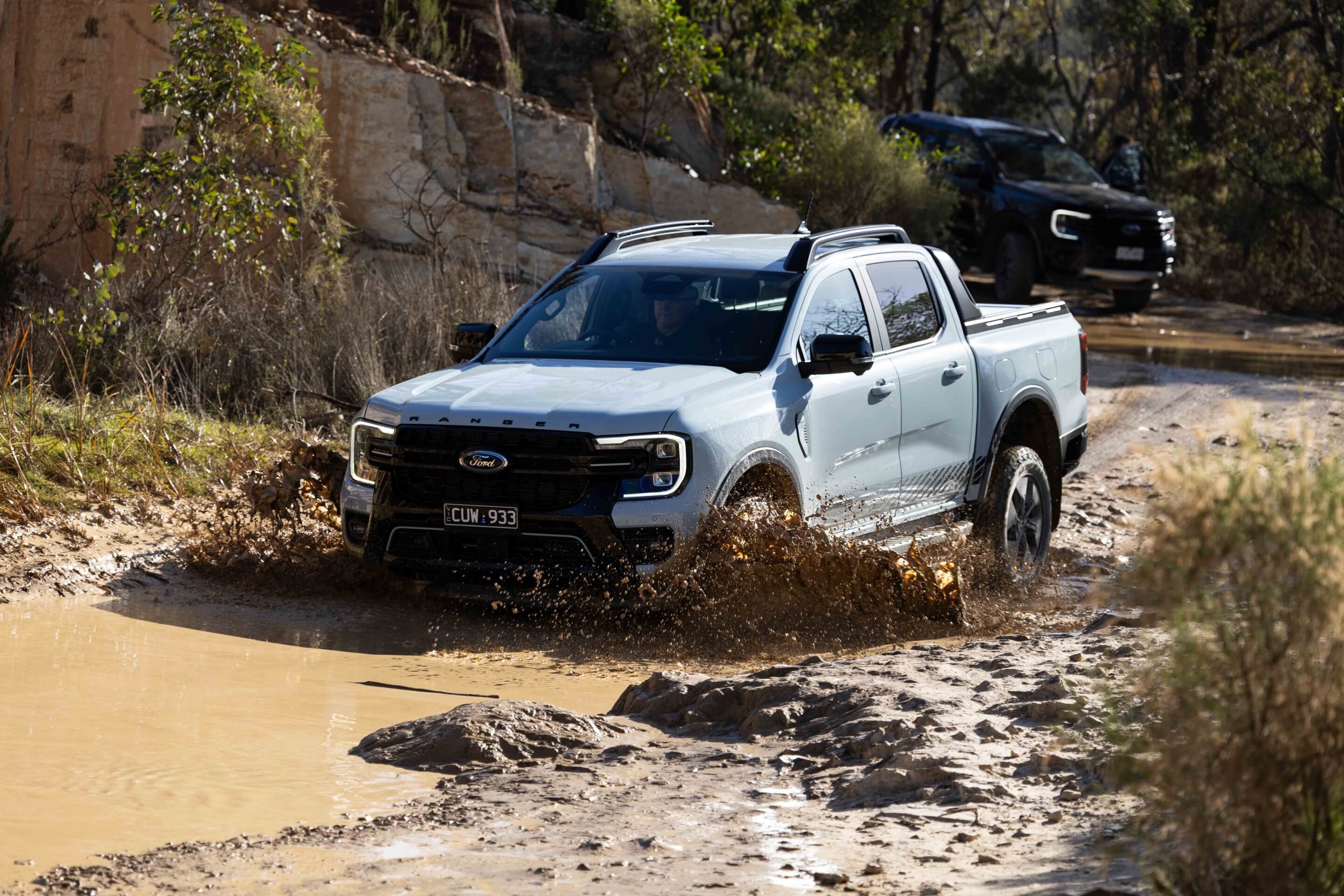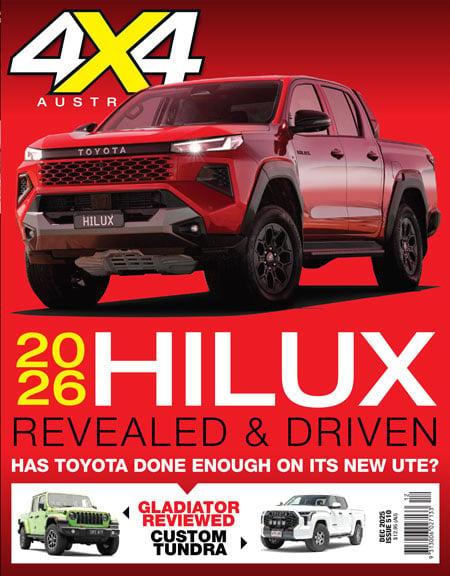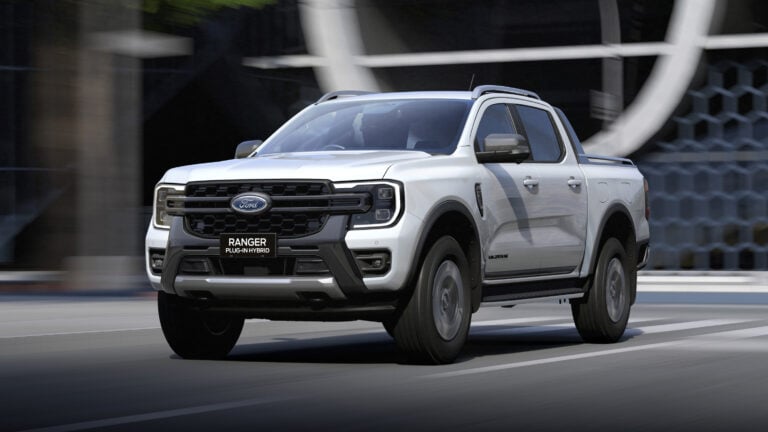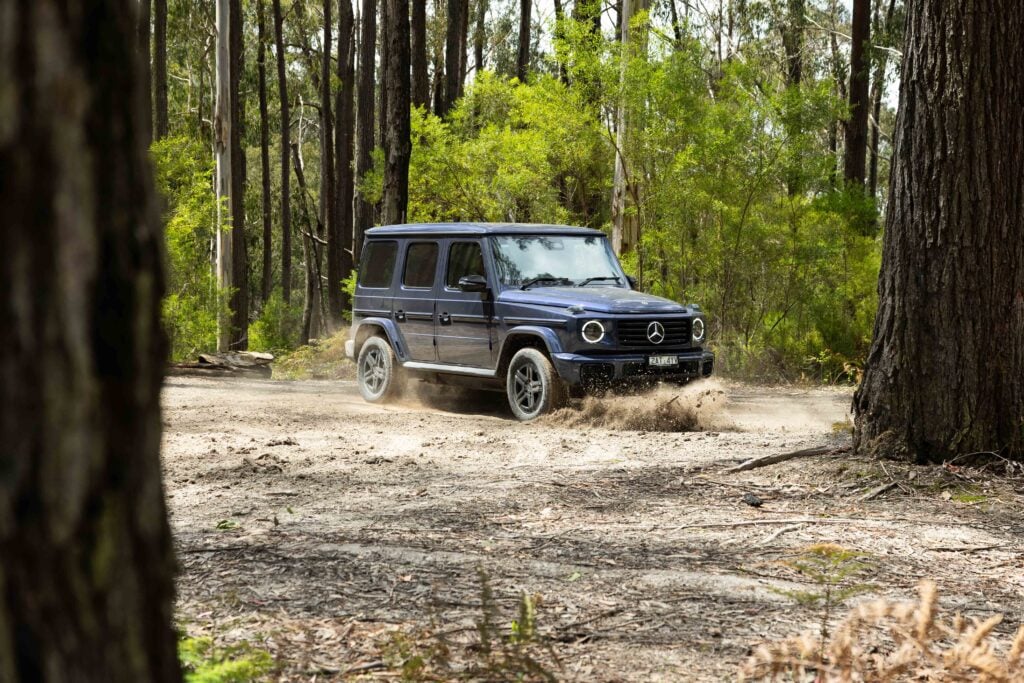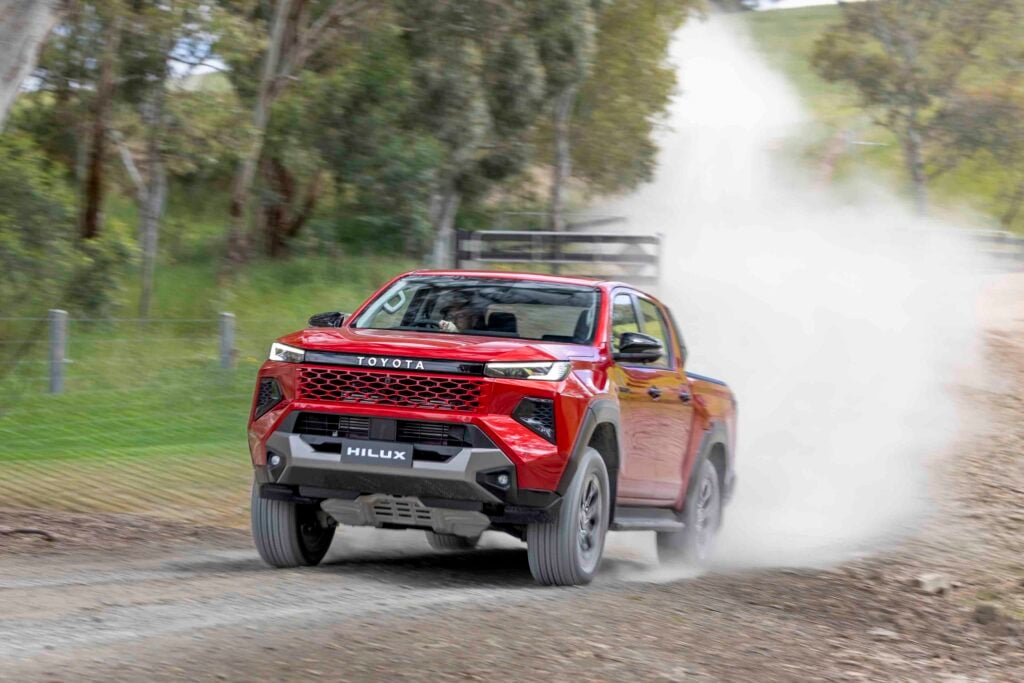Things we like
- Refined driveline with loads of torque for off-roading and towing
- Genuine off-road capability equal of diesel variants
- Hybrid driveline results in good fuel economy and electrical power when you reach the campsite
Not so much
- Smaller battery than some competitors
- No DC fast charging facility
- Heavier than diesel variants and therefore less payload capacity
- You can’t remove the tub to fit a tray or canopy
Ford has added a plug-in hybrid to its top-selling ute range, and the Ranger PHEV is more than just a fuel-saver – it’s a refined, powerful and highly capable dual-cab ute that is effective for work, touring and off-road conditions.
At the heart of the new model is a 2.3-litre turbocharged four-cylinder petrol engine paired with a 75kW electric motor and an 11.8kWh battery. On its own, the 2.3-litre petrol engine makes a claimed 138kW at 4600rpm and 411Nm at 2700rpm, but combined output is a stout 207kW at 4600rpm and 697Nm at 2500rpm, fed through a 10-speed Modular Hybrid Transmission (MHT) and a full-time 4×4 system lifted from the Ranger Raptor. This includes a locking rear diff, low-range and an Auto 4WD setting that works well on mixed terrain.
Ford claims 2.9L/100km combined fuel consumption under lab testing, and a battery-only range of 45km (WLTP), but on our real-world drive – starting in Auto EV mode – we covered around 27km on battery alone before the battery was depleted and the petrol engine took over. Over a 60km mixed loop, our average fuel consumption was 6.9L/100km, which is still impressive for what is a fairly large dual-cab ute with serious off-road chops. A regenerative braking system helps charge the battery which aids efficiency in stop-start driving scenarios; there is an EV Coach in the instrument cluster aimed at helping drivers make the most of the system.
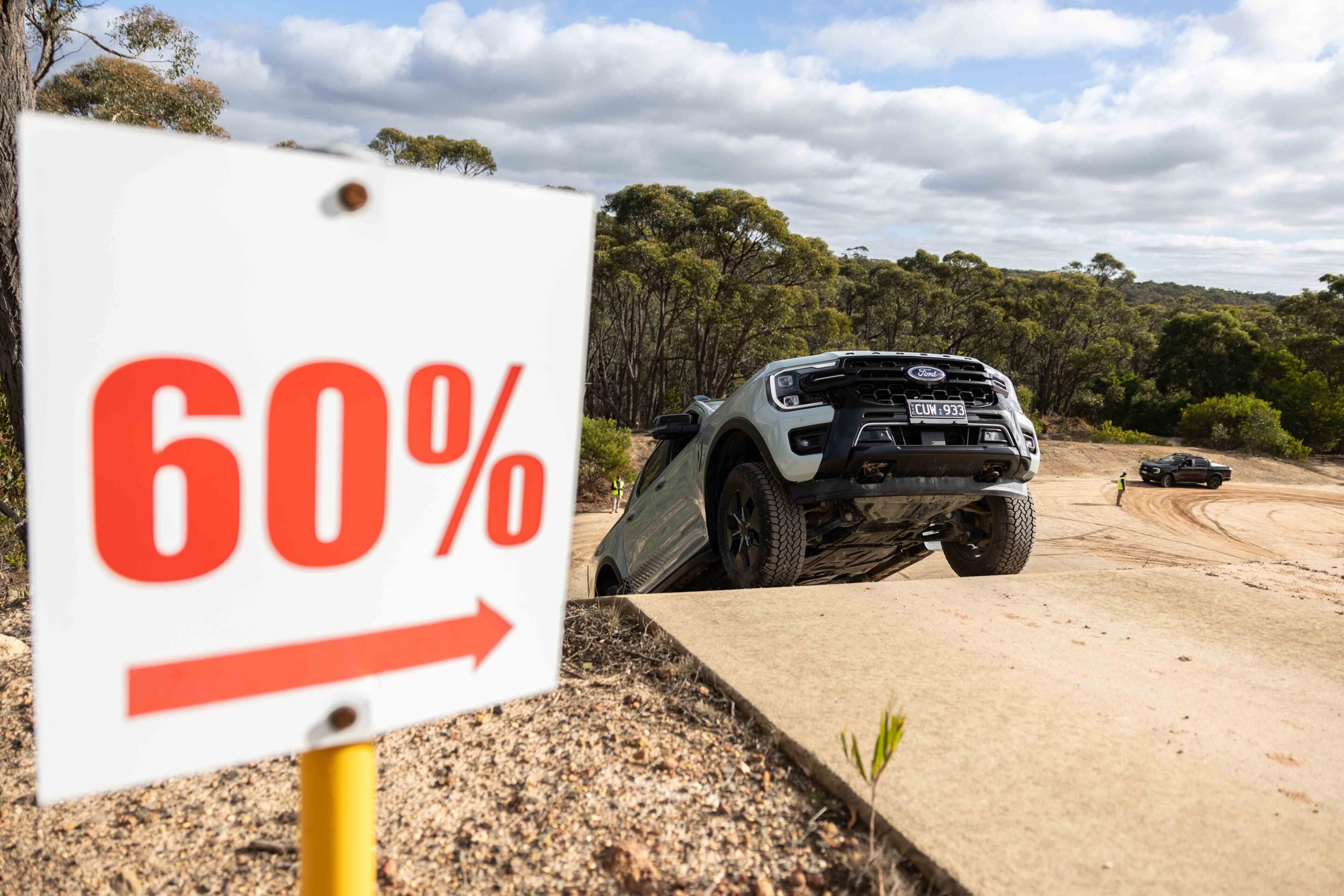
The addition of the battery and electric motor system means the Ranger PHEV is significantly heavier than its diesel siblings, with kerb weights ranging from 2527kg in the XLT to 2692kg in the fully optioned Stormtrak – around 240-400kg heavier than an equivalent 3.0L V6 diesel model. That extra weight eats into payload, with figures dropping as low as 808kg in the Stormtrak.
It should also be noted that the quoted payload figures are without the spare wheel/tyre hanging under the tub, as this vital component is now offered as a no-cost option; we can’t help but think the reason for this is down to marketing as the deletion of the spare as standard equipment means around 20kg can be added to the payload figure across the range. While still capable of towing a 3500kg braked trailer, prospective owners will need to pay close attention to gross vehicle mass (GVM) and payload calculations if loading the tub or hitching up a heavy trailer.
JUMP AHEAD
Model range
The Ranger PHEV is available in four trim levels – XLT, Sport, Wildtrak and Stormtrak – with drive-away pricing ranging from $71,990 to $86,990.
The XLT offers the essentials, including full-time 4×4, selectable EV drive modes, and Pro Power Onboard with up to 6.9kW of AC output. Stepping up to the Sport ($75,990 drive-away) adds leather-accented trim, heated seats, wireless charging and LED lighting.
The $79,990 Wildtrak introduces matrix LED headlights, power roller shutter, unique styling and a 10-speaker B&O sound system. At the top of the range, the Stormtrak ($86,990 drive-away) includes exclusive Chill Grey accents, a flexible rack system, unique 18-inch wheels, and factory-fitted auxiliary switches for powering aftermarket gear.
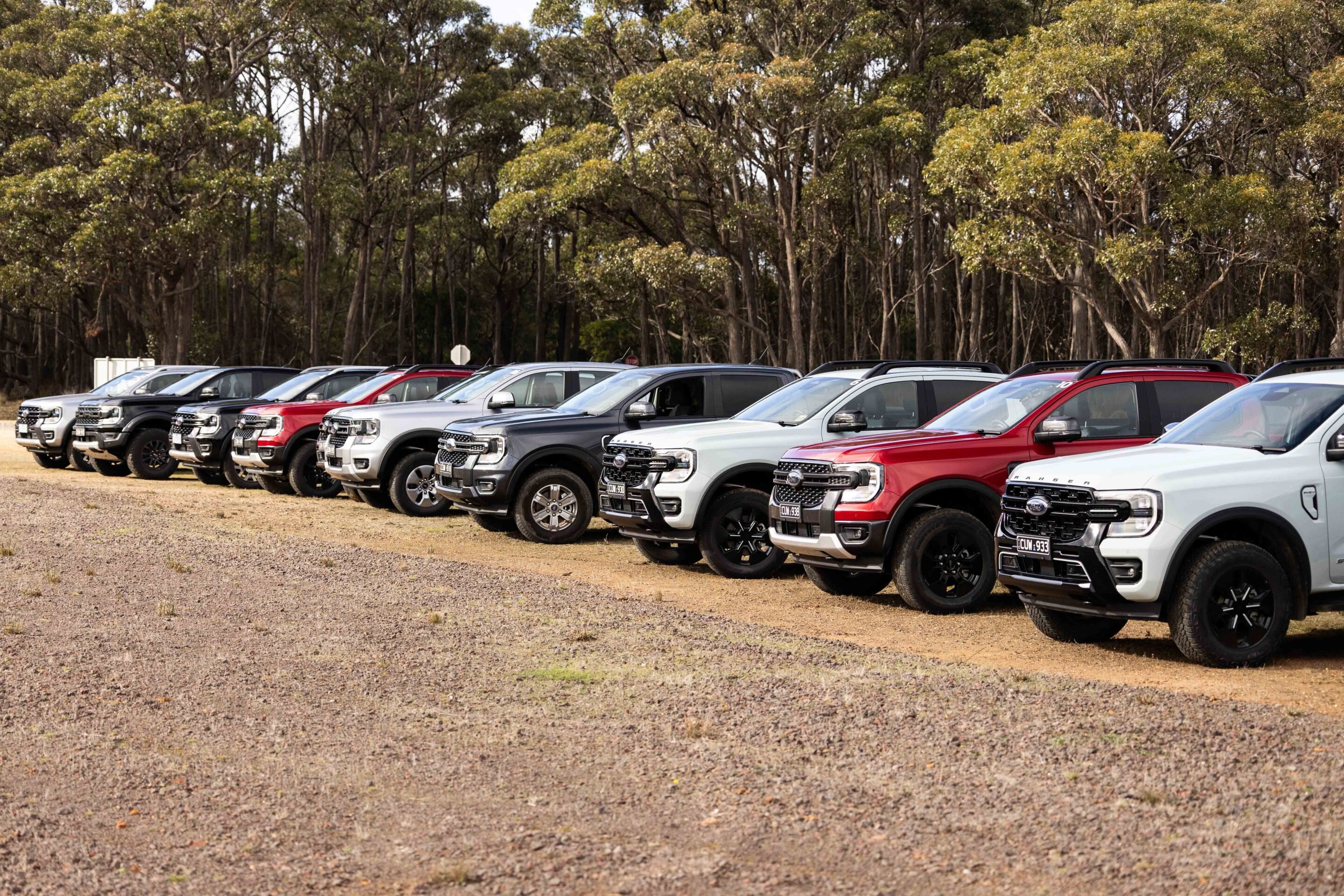
Power pack
Charging the Ranger PHEV is as easy as plugging in your smartphone.
The vehicle is supplied with a Mode 2 home charging cable and can be topped up overnight using a standard 240V wall socket. From empty to full, the 11.8kWh battery takes just under seven hours to charge on a 10A outlet, or around four hours on a 15A socket – ideal for those wanting to start the next day’s commute with a full charge and minimal fuel use.
The Ranger PHEV does not offer DC fast-charging, but if you’re away from a power source or just want to replenish the battery on the move, selecting EV Charge mode turns the petrol engine into a generator. This is ideal when you want to use the Ranger’s Pro Power Onboard system to run 240V appliances at a worksite or campsite – things like power tools, a bar fridge, a coffee machine or even a Travel Buddy oven. It also ensures you’ve got enough stored energy to charge up an electric bike or other kit when you arrive at your destination.
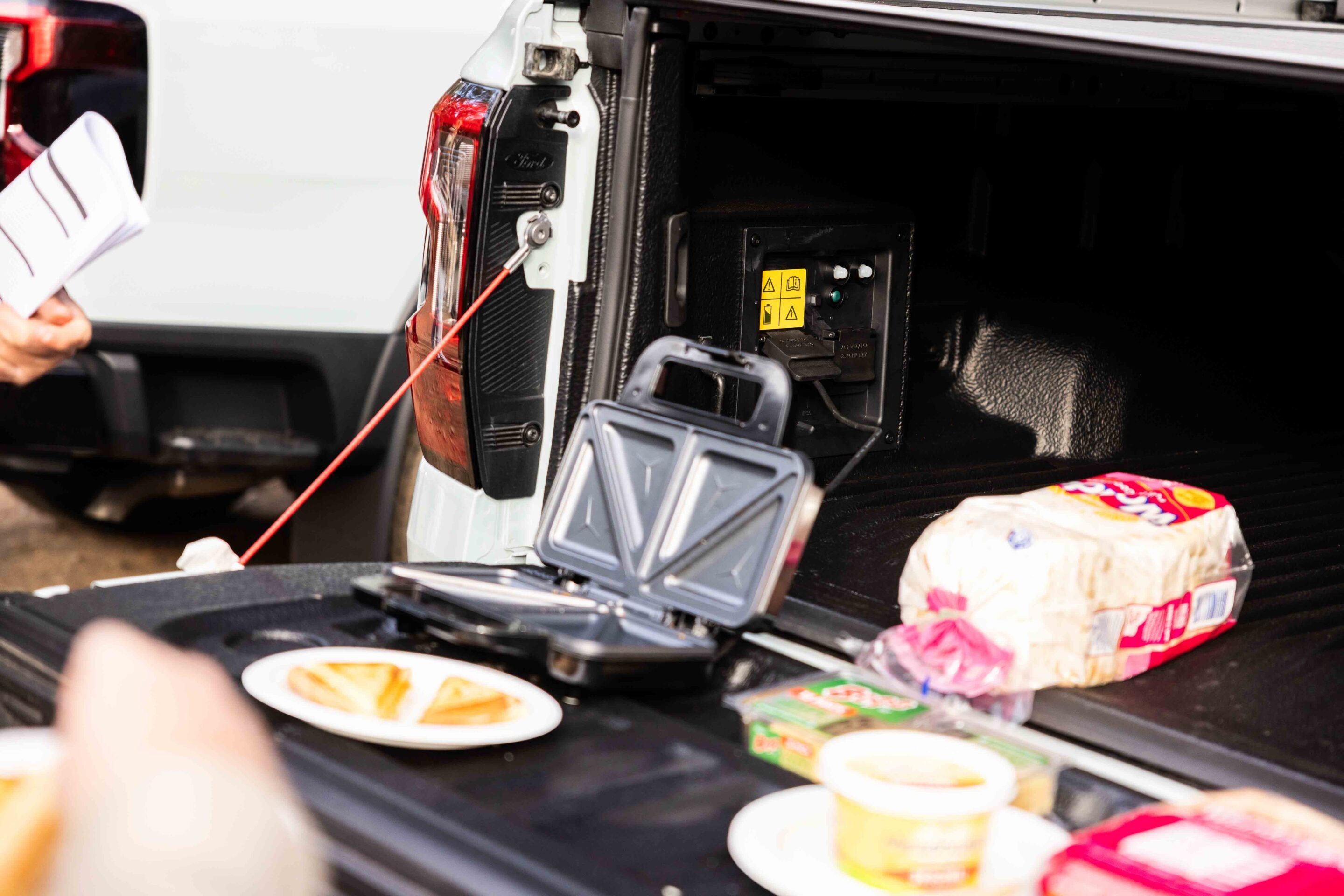
There are three AC power outlets; two 3.45kW (15A @ 230V) outlets in the tray and a 2.3kW (10A @ 230V) outlet in the cabin. Once the 11.8kWh battery is depleted, it can be recharged by simply firing up the engine and selecting EV Charge mode; Ford describes it as a portable generator with a 70-litre fuel tank.
Theoretically, if you were staying at the one campsite for an extended period, you could also charge the battery from solar panels, but you would need to use an inverter and charge through the standard AC input using the supplied Mode 2 home charging cable.
On the road
On bitumen, the Ranger PHEV feels more refined than its diesel siblings.
The petrol-electric drivetrain is smooth and quiet, with acceleration that easily rivals the V6 diesel. Put your foot down and this Ranger hauls. The electric motor fills in any gaps from the turbo-petrol engine and the result is strong, seamless torque delivery.
Even towing a 2.8-tonne trailer and digger combo, the PHEV felt untroubled. While we didn’t record fuel figures during towing, it’s clear the hybrid system helps with low-speed grunt, making for effortless take-offs and confident hill starts. There’s also a Pro Trailer Back-up Assist system on Wildtrak and Stormtrak model grades, with a dial in the centre console to aid reversing with a trailer attached.
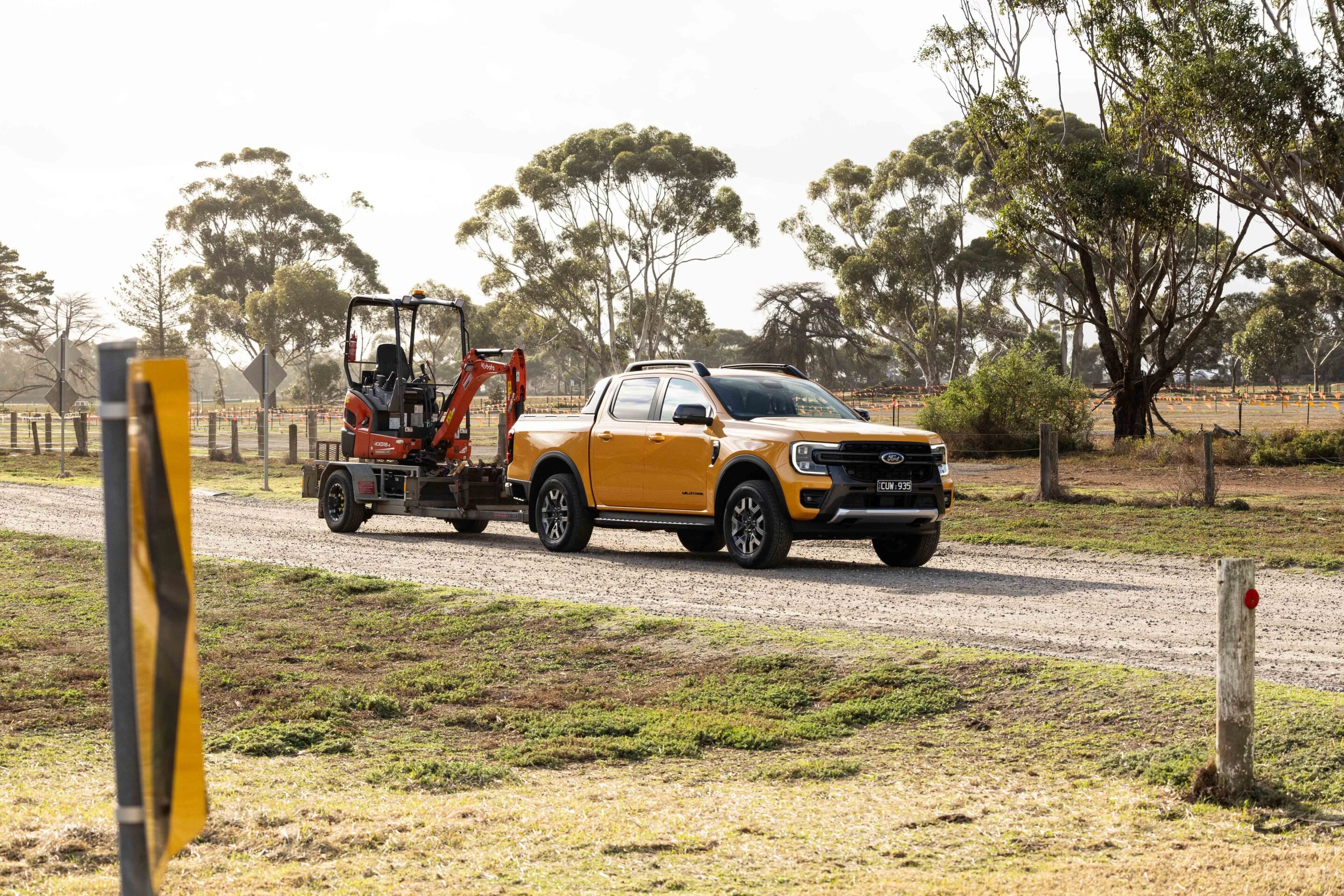
Handling is well sorted too. Steering is nicely weighted, body control is tight, and unladen ride quality is good. The Ranger PHEV is heftier than its diesel counterparts and much of this weight (the battery) is towards the rear of the vehicle, and this no doubt helps to settle the rear end when driving over bumpy roads. Lane-keep assist works unobtrusively and, unlike some rivals, there’s no incessant beeping.
The hybrid system offers four drive modes: Auto EV, EV Now, EV Later and EV Charge. In EV Charge mode – which uses the engine to replenish the battery – we recorded 9.6L/100km on a highway leg, and it would take around two hours of driving to fully charge from empty. This was on a vehicle equipped with optional General Grabber A/T rubber (255/65R18), so you could eke out a bit more fuel economy if you were on the standard Continental ContiCrossContact H/T tyres. Regardless, with a 70-litre tank, the theoretical touring range on the open road is more than 700km.
Speaking of the open road, Ford Australia was at pains to point out that it has the second-largest dealer network in the country; a subtle dig, no doubt, at the new Chinese players on the market that are eating into the market share of traditional nameplates.
Off the road
We tackled a few off-road challenges on the launch drive, including a short run on a tricky track in Lerderderg State Park on Day 1 and several off-road courses at the Australian Automotive Research Centre (AARC), a facility that 4X4 Australia has used previously for 4X4 Of The Year testing.
Like other Rangers, the PHEV variants feature driver-selectable modes (Normal, Eco, Tow/Haul, Slippery, Mud/Ruts, Sand and Sport) in addition to its EV Drive modes. The track in Lerderderg was steep and slippery in places and was good for testing the effectiveness of the Ranger PHEV’s drive modes, low-range gearing, rear diff lock, traction control, ground clearance and off-road angles. If you are familiar with the performance of a diesel Ranger off road, this will give you a fair idea of how the Ranger PHEV performs, which is to say it’s an impressive bit of kit.
On the test loop at the Australian Automotive Research Centre, the Ranger PHEV clambered up 60 per cent grades in 4 Auto mode using EV power only. The petrol engine only joined in when needed, doing so quietly and smoothly. In really tricky situations you would obviously select low range and lock the rear diff, in which case the petrol engine would automatically fire up.
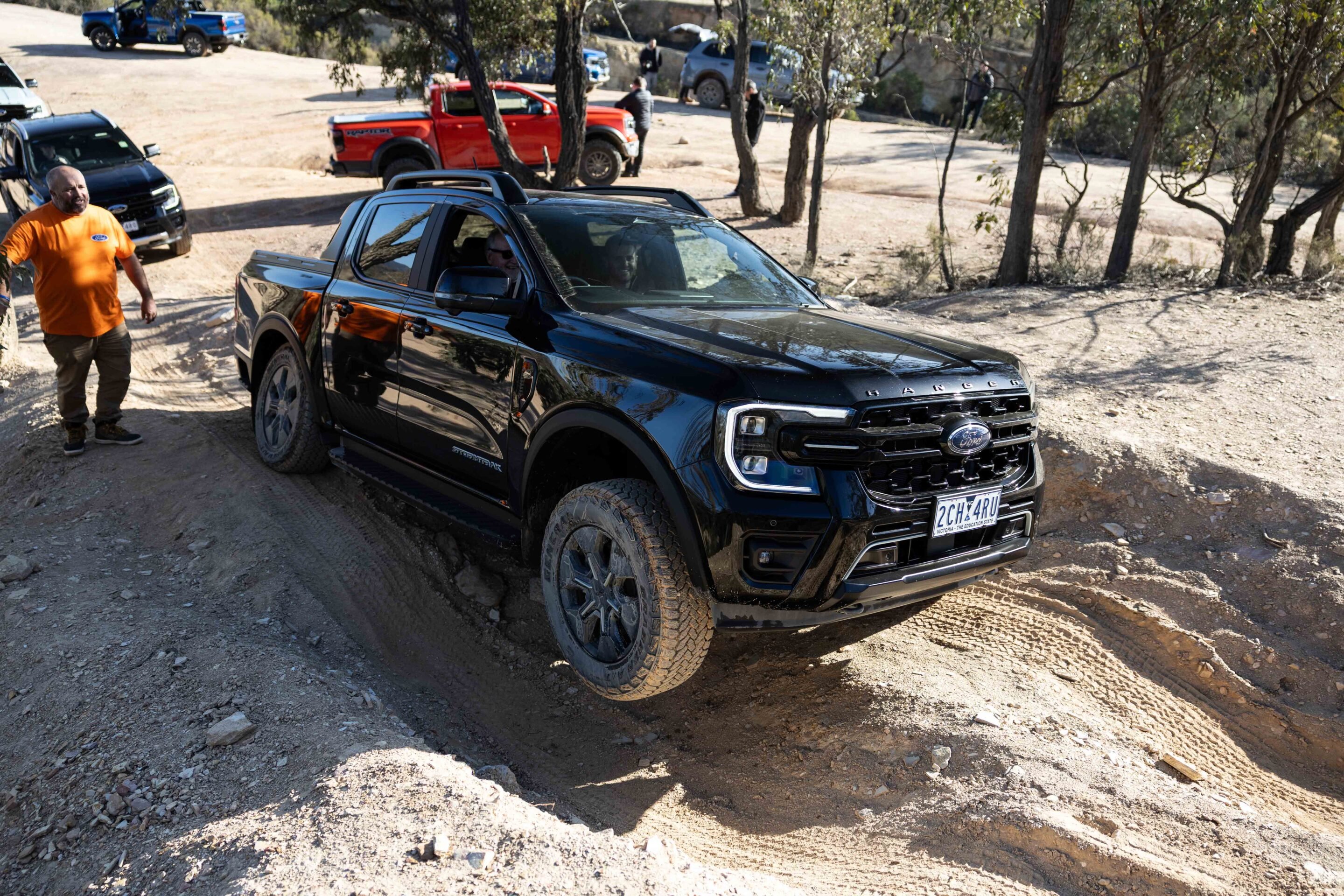
Hill Descent Control is excellent. Speed is adjustable in 1km/h increments via the cruise control buttons, and the system works quietly, without the whirring of older-generation systems. Forward camera vision is great for cresting hills, and Ford has thoughtfully added a washer jet to keep it clean.
Like other Rangers, wading depth is quoted at 800mm. It should be noted that the engine air intake is forward facing just below the lip of the bonnet, so fitment of a snorkel would be a good idea for 4×4 touring.
There’s a unique joy to off-roading in near silence. With the windows down and the electric motor engaged, you hear only tyres on gravel and the sounds of birds and bush. It’s an entirely entertaining way to experience a track, and even when the electric engine kicks in, the Ranger PHEV is still quieter than the diesel variants, and it’s this refinement that many buyers will find attractive.
| Measurement | Value |
|---|---|
| Approach Angle | 28.9 – 30.2 |
| Ramp Over Angle | 19.6 – 20.4 |
| Departure Angle | 23.9 – 24.7 |
| Ground Clearance | 215 – 228mm |
| Wading Depth | 800mm |
Interior and exterior
Step inside and the Ranger PHEV feels familiar.
The interior mirrors that of the diesel Ranger, which means good ergonomics, supportive seats and a massive 12-inch portrait centre screen that thankfully retains physical dials for volume and climate control, making on-the-fly adjustments easier than systems buried entirely in menus.
New features include a dash-mounted button to open the fuel filler (necessary for the pressurised fuel system) and a charging port with a locking function on the passenger side.

Out the back you can’t remove the tub to fit a tray or canopy – the location of the battery, the integrated wiring and the 240V outlets rule that out – but the tub is otherwise well set up. There are cut-outs in the tub liner to accommodate long items, while a pair of adjustable top-rail tie-downs and a 31mm raised bed floor (to accommodate the battery) distinguish it from other Ranger trays.
Underbody protection has been fitted to prevent damage to the battery pack when driving off road, but take a peek beneath the passenger-side sill and you’ll spot an orange electrical conduit mounted on the outside of the chassis rail, and while it doesn’t hang low, it looks like it could be vulnerable to debris strikes – a small guard here would be welcome.
Model line-up and pricing
XLT – $71,990 drive-away
- Full-time 4WD with EV drive modes
- 17-inch alloy wheels, halogen lighting
- Cloth trim, manual seats
- Pro Power Onboard (6.9kW max output)
- Rear diff lock
- Adaptive cruise control
Sport – $75,990 drive-away
Includes XLT features, plus:
- 18-inch alloy wheels, LED lighting
- Leather-accented trim with heated front seats
- Power-adjustable driver’s seat
- Wireless charging
- Dark exterior accents
- Enhanced driver assist with Stop & Go
Wildtrak – $79,990 drive-away
Includes Sport features, plus:
- Matrix LED headlights
- Power roller shutter & roof rails
- Unique grille and sailplane design
- B&O 10-speaker premium audio system
- 360-degree camera
- Pro Trailer Backup Assist
Stormtrak – $86,990 Drive-Away
Includes Wildtrak features, plus:
- Chill Grey accents & exclusive wheels
- Flexible rack system and advanced cargo management
- Auxiliary switch bank (standard)
- Unique leather seats with Stormtrak trim
Specs
| Specification | Details |
|---|---|
| Price | $71,990 (XLT); $75,990 (Sport); $79,990 (Wildtrak); $86,990 (Stormtrak) |
| Engine | 2.3L turbo petrol four with 75kW electric motor |
| Capacity | 2.3L petrol + 11.8kWh battery |
| Max Power | 207kW (combined) |
| Max Torque | 697Nm (combined) |
| Transmission | 10-speed automatic |
| 4×4 System | Selectable full-time 4WD, dual-range |
| Construction | 4-door ute on ladder frame chassis |
| Front Suspension | Independent front suspension, double wishbones, coil springs |
| Rear Suspension | Live axle with leaf springs |
| Tyres | 17-18 inch (A/T optional) |
| Kerb Weight | 2527-2692kg |
| GVM (Gross Vehicle Mass) | 3500kg |
| GCM (Gross Combined Mass) | 6580kg |
| Towing Capacity | 3500kg |
| Payload | 808-973kg (no spare fitted) |
| Seating Capacity | 5 |
| Fuel Tank Capacity | 70L |
| ADR Fuel Consumption | 2.9L/100km (claimed) |
| On-Test Fuel Consumption | 8.3L/100km (predominantly highway; Auto EV/EV Charge modes) |
Verdict
Ford’s first plug-in hybrid ute is more than a stepping stone toward electrification – it’s a genuine dual-cab workhorse with real-world benefits.
Sure, it runs a much smaller-capacity battery than its obvious rivals, but the Ranger PHEV hauls, tows and climbs with ease. It brings strong performance, low fuel use and added refinement over diesel models, while keeping all the off-road gear intact.
While it doesn’t have quite the same electric-only range as some competitors, it makes up for it with a proper mechanical 4×4 system, full towing capacity (3500kg) and a well-integrated hybrid driveline. The onboard Pro Power system adds serious appeal for campers and tradies needing AC power on the worksite or at the campsite.

Until full electric utes catch up on range, and a comprehensive nation-wide charging infrastructure is in place, the PHEV powertrain looks to be the sweet spot – and Ford’s execution of it in the Ranger is very well resolved.
Of course, the Ranger PHEV will not be for everyone, particularly those who want to fit a tray or canopy, but despite not having the electric range of some of its competitors, including the new GWM Cannon Alpha, there’s no doubt Ford has done its homework and has developed a compelling hybrid ute for those looking at an alternative to diesel ute offerings.
Things we like
- Refined driveline with loads of torque for off-roading and towing
- Genuine off-road capability equal of diesel variants
- Hybrid driveline results in good fuel economy and electrical power when you reach the campsite
Not so much
- Smaller battery than some competitors
- No DC fast charging facility
- Heavier than diesel variants and therefore less payload capacity
- You can’t remove the tub to fit a tray or canopy

